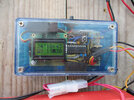I appreciate your information , I am a very amateur C guy.. and way past my 3 score and ten , only half a dozen grey cells left ... That said your picture looks very interesting , Cheers
This project is way back in my win XP and Eagle days( 2008 ). I no longer have the files well cannot find them

The controller started with a sw and 3 {up /down/next buttons }, the last version used IR so I could seal the box , moisture not good for copper strip boards

I have been writing code since early 70's. Mostly now C and I am experimenting with
block languages, visual programming. I use it for simple straightforward control projects,
its faster to get up a project (no need for cheat sheet or manual by your side to insure typing
is correct), dont have to worry about variable size (for the most part), moves coder away from
strong typing type languages, like C, and is less prone to errors. Again simple stuff.
MIT, schools (6 year olds do robots), google all very active in visual languages.
I see it as the same state as C was when it was introduced. I am still waiting on a
telepathic language that just takes my thoughts and produces code. Soon I
think....

By the way the pic I showed of all the resources, they each come with a rich set
of APIs, so you largely just use API f() calls to do your coding. Many designs can be done
codeless as well just from the initial click/configure activity. Where one does not need
at runtime changes in HW....
Regards, Dana.



